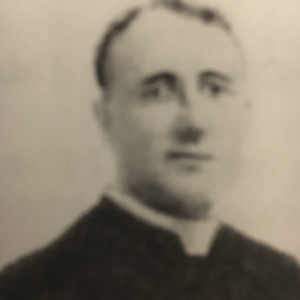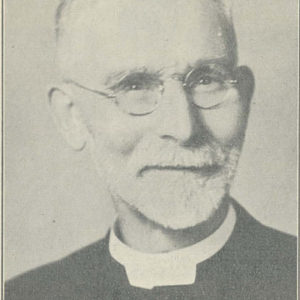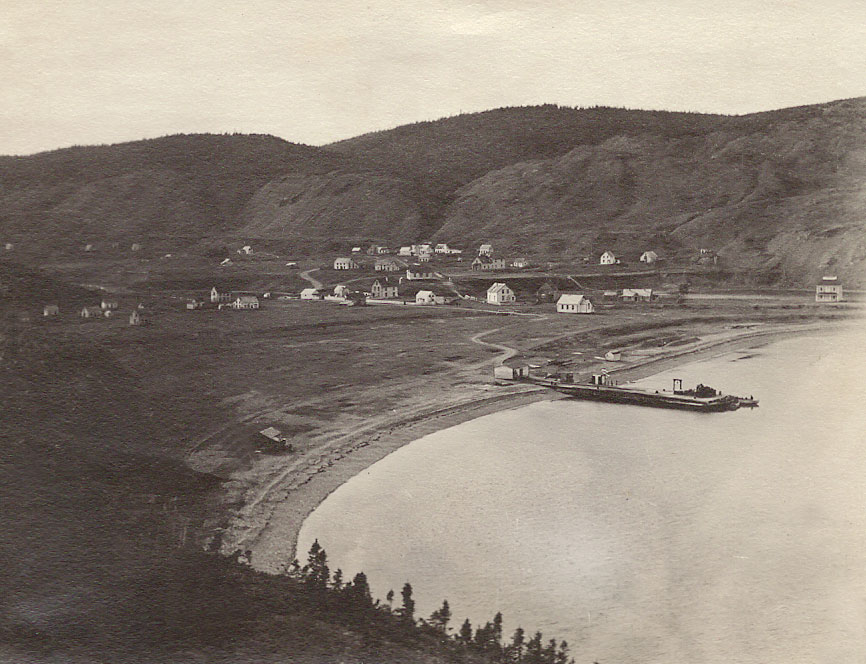*Pictures included are: town before fire showing where it started (behind brown building above ridge on right), Rev. John J. Lynch, Rev. Arthur Pittman, Picture of town after fire for comparison.

Sometimes I get lucky and find multiple firsthand accounts of an incident. In this case Rev. Arthur Pittman wrote of his experience in Diocesan Magazine and Rev. John J. Lynch gave an interview to the Evening Telegram. Obviously more would be better but just having a couple of eyewitnesses clears our view a lot. In this piece I’ll draw heavily from those two sources along with some newspaper references and my general knowledge of the context. I might even have an insight or two. The benefit of using original sources and the problems of either referencing sources written after the time of an event or taking any single source at its word are highlighted by Little Bay’s 1903 fire.
Little Bay had a lot of fires both accidental and otherwise. Most only burned a building or two. It had four, however, of what I call major fires; 1881, 1888, 1903, and 1904. This is the telling of the 1903 fire. It’s not easy to separate references to Little Bay’s 1903 and 1904 fires in sources published later. The two fires appear as if they’re one event. One that takes place in 1904 which is to say it’s like there was no 1903 fire. At first glance it’s not obvious that there was one. I’m proud of just finding it. I might be the first researcher to take note that it happened at all. That sounds like a bold claim so please allow me to explain.
First, I’m going to set the conditions for the 1903 fire in Little Bay. May was a dry month. While there was still ice in the harbour there was little precipitation. Little Bay hadn’t seen rain in two weeks. There was a vicious north wind blowing. The town was also nearly vacant. Little Bay had a population of over 2000 people in 1891 but there were less than 700 people there in 1901. With the mines closed that number would still be rapidly dropping in 1903. Rows of houses owned by the mining company stood empty. Of those remaining most men would be away fishing to feed their families back home.
 The day before the fire was a Sunday. The churches held their weekly services not knowing it would be their last. Father John J. Lynch would have walked down the stairs from Her Lady to the Bight before going to his home situated behind the Court House above Captain’s Pond (it’s right behind the brown building on the right in the picture). He’d taken over the property after Little Bay’s longstanding priest Father O’Flynn had been killed in a carriage accident while visiting St. John’s four years prior.
The day before the fire was a Sunday. The churches held their weekly services not knowing it would be their last. Father John J. Lynch would have walked down the stairs from Her Lady to the Bight before going to his home situated behind the Court House above Captain’s Pond (it’s right behind the brown building on the right in the picture). He’d taken over the property after Little Bay’s longstanding priest Father O’Flynn had been killed in a carriage accident while visiting St. John’s four years prior.
The fancy house had a French roof and well kept garden. There was an adjacent kitchen attached to the building. His predecessor had a housekeeper so one may have been cooking. It was on the roof of this adjoining kitchen that the fire started. The true cause of the fire is unknown but in his interview article its postulated that sparks from the kitchen flue ignited dry shingles on the roof. Rev. Lynch was sitting in his dining room on that Monday afternoon. He took awhile to identify the odd sound he was hearing. He walked into his hall to investigate and spotted the ceiling above the stairs. It was on fire. He was hearing tar and dry wood burning above.
He sounded an alarm but others outside had spotted smoke rising from the clapboard along the eve of his house by then. The fire had had time to get going and the conditions were ripe for the growing flames. They’d noticed it too late. It would not be contained so they rushed to empty their houses of furniture and valuables as was the custom. We saw this during the 1888 fire. They’d drag cabinets and beds into any nearby water if there was time. There wasn’t time. This one was fast.
The mighty north wind first blew flankers onto the roof of Mr. Foote’s office. From there it jumped onto the Company Store. It shot up the road and burned out house after house on both sides as it raced across the Bight. The wind lifted coals and flaming shingles high into the air until the centre of town was made aflame. The inferno rained down from above as it raced toward the two churches situated on the hill above the blaze.
 St. Luke’s and Her Lady of Carmel sat atop the hill overlooking the Bight. Pittman notes how they thought the placement would spare them from any fires below. This day proved them wrong. The fire rushed at them and each were levelled in a matter of minutes. Pages of scorched books blew about with the smoke and cinders. Many were carried up and away. Remnants of Little Bay’s letters and documents were later found on Sunday Cove Island. Two pages from St. Luke’s burial register flew all the way to Robert’s Arm – a journey of over eight miles. They were sent back by mail. There was nothing else left of St. Luke’s but ash and molten glass. The bell from the Catholic Church survived. It resides now in St. Patrick’s. The communion vessels of St. Andrew’s were saved by Mrs. Lind. Her daughter gave them to St. Matthew’s in Grand Falls in 1963. I inquired but they’re no longer there. They might be in Tilt Cove.
St. Luke’s and Her Lady of Carmel sat atop the hill overlooking the Bight. Pittman notes how they thought the placement would spare them from any fires below. This day proved them wrong. The fire rushed at them and each were levelled in a matter of minutes. Pages of scorched books blew about with the smoke and cinders. Many were carried up and away. Remnants of Little Bay’s letters and documents were later found on Sunday Cove Island. Two pages from St. Luke’s burial register flew all the way to Robert’s Arm – a journey of over eight miles. They were sent back by mail. There was nothing else left of St. Luke’s but ash and molten glass. The bell from the Catholic Church survived. It resides now in St. Patrick’s. The communion vessels of St. Andrew’s were saved by Mrs. Lind. Her daughter gave them to St. Matthew’s in Grand Falls in 1963. I inquired but they’re no longer there. They might be in Tilt Cove.
Most of the Bight was gone in only a couple of hours. In the end the town lost 34 homes with all furniture and provisions, 3 churches, 1 school, the public hall, the post office containing both the telegram and customs offices, many shops and stores, the mining and government offices, the masonic hall, and the government wharf. It missed the Court House somehow despite it being between Rev. Lynch’s house and St. Andrew’s. Probably a credit to Sergeant Wells’ efforts.
90 families were made homeless but easily rehoused with all the vacancies around. There was $30,000 in damages but the mining company properties were insured. The churches were not due to their declining congregation numbers. I can find no report of death or even injury which is something considering how suddenly it spread. The losses were largely financial. The greatest sufferers being William Walker, Robert Tiller, and Ed Warren.
Little Bay started rebuilding immediately. In St. John’s the government responded quickly to the crisis. Little Bay was discussed by the House of Assembly and the Honourable Robert Bond did what he could for the town. He even started a journey to visit but got called back while on route. Supplies were sent to Little Bay on the S.S. Virginia Lake within a day of the news but there was ice still blocking bays so it could not make it the whole way.
Rev. Lynch left for St. John’s to collect funds. He had a difficult week. He took a train which derailed a few miles outside of Bishop’s Falls resulting in a death. Rev. Lynch saw to the man. In the city he stayed with Mrs. Gosse at the Metropolitan House on Water Street. While he was there the 70 year old lady fell down the stairs and was injured. He tended to her as well. St. John’s supported his efforts and he stopped in his hometown of Harbour Grace on his way back to collect even more funds.
The miner’s houses in Little Bay were not likely rebuilt but the churches and wharf were started. They got a new telegram that November. I doubt it lasted a year. A mere 15 months from this fire the town was struck again by another fire. The 1904 one was a lot scarier. Back when I started researching Little Bay I, like most people familiar with the place had heard that the once booming town had been wiped out by a fire at the turn of the century. Very little digging was required to find that many towns in that part of Newfoundland were devastated by a great forest fire in August of 1904. Every reference I found citing the loss of mining and church records in Little Bay credited that fire. They also all only had the one fire. I have not seen the 1903 fire mentioned outside of reports from its time but it was big news. There was an international press release published across dozens of American newspapers that year. It gets all the numbers wrong, however. The whole event is absent from local histories you’d expect to have it like “Moments in Time” and Boyles’ “History of the United Church Springdale” which credit all damages to the 1904 blaze. Moncrief’s “History of the Presbyterian Church in Newfoundland” puts the fire in 1905.
It came as quite a shock when I first found a press release in an American newspaper from 1903 saying Little Bay, Newfoundland was destroyed by fire. I first figured the year of the event had been recorded wrong as, like I said, someone placed it in 1905. The more sources I found, however, the more that couldn’t account for it. There were two fires that burned down Little Bay back-to-back in 1903 and 1904.
My guess is that the 1903 fire happened while the town was quickly shrinking. It made the news because of what the place had recently been in the public mind not for where it was in that present. Plus, while the damages were substantial no lives were lost. I haven’t even found any injuries. On top of that most of the buildings burned were insured by the mining company and few needed to be replaced because of the population decline. They had no need to rebuild most of it and what was under construction was cut short by the following fire. The new churches and wharf likely didn’t see a year before a forest fire swept away the work. It must have felt like such wasted effort and that on top of the place itself dying already. The 1903 fire took out the Bight and the 1904 fire overtook that whole area of the island destroying multiple surrounding communities including the St. Patrick’s part of Little Bay. It dwarfed the event of the previous year and rebuilding again after both fires and without their industry must have felt absolutely futile. No wonder so few stayed. The ones that chose to stay built over loss and damage with only hopes and dreams of the boom starting over.
I think those all combine to erase the fire in 1903. The oral record focused on the greater fire that followed. It was shared by many more surrounding people’s experiences. Later researchers and writers would see that records were lost to fire and correlate it with an established event. Oral records and written research synced up and accounted for everything by only referencing 1904. There was no reason for anyone to look for a 1903 blaze. It didn’t look like anything was missing. It was an accident that I stumbled across it at all despite the numerous sources available. My work involves categorizing all references to Little Bay so I can find things I’m not looking for. Otherwise I think it’d be difficult to look for something you didn’t know about. On top of all of that the press release sent out to dozens of newspapers got facts wrong. Many place the number of homes lost at 90 and the number of homeless as high as 250. Rev. Lynch corrected the numbers in his interview but it goes to show the need for multiple perspectives on an event.
I hope you enjoyed this piece. I don’t often wander into the 20th century but the claim that Little Bay’s documents were lost to the 1904 fire didn’t sit right. I think it’s more likely that 1903’s blaze was the culprit. Plus I needed to check my references against more modern sources to make sure this event was really absent. It sure looks like it. Stuff like this is why Little Bay’s history so fascinates me. It’s wild how something can be both lost and so well documented. The 1903 fire feels like a metaphor for Little Bay’s whole story. It’s all there – it just needs to be put together. I needed to combined Pittman and Lynch’s perspectives to write this one. If you have journals or letters referencing historical Little Bay I hope you’ll consider adding them to the mix. It’s not enough for history to be written down. Writing is made valuable by the reading. Thanks for reading!

Sources:
- Virginia Lake sent with supplies (ET, May 21, 1903)
- Rebuilding shipping wharf (ET, June 2, 1903)
- Train accident (WS, June 17, 1903)
- Rev. Lynch interview on fire (ET, June 20, 1903)
- Rev. Lynch in Harbour Grace (HGS, June 26, 1903)
- Rev. Lynch collection in St. John’s (ET, June 27, 1903)
- Mrs. Gosse falls (ET, June 29, 1903)
- Pittman article (Diocesan Magazine, July, 1903)
- Lynch leaves St. John’s for Harbour Grace (ET, July 17, 1903)
- Proceedings of the House of Assembly (ET, July 23, 1903)
- Collection taken up for Little Bay (ET, Aug 26, 1903)
- Telegraph installed (ET, Nov 16, 1903)
- Press Release (Various)
